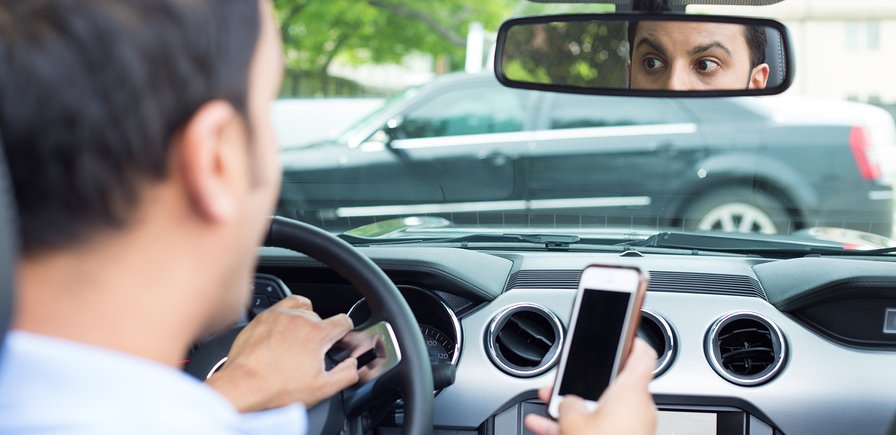You are most certainly aware of the importance of never driving a car while under the influence of alcohol or drugs. And let’s hope most of us are also extremely careful about not texting while driving and only using hands-free devices in the car. But there may be something else that we all do behind the wheel at one time or another that you may not even be aware is putting you in danger. New research suggests that following someone else in another car to get to the same destination can result in some serious driving errors.
The study, which took place at Arizona State University in Tempe, found that following behind a friend’s car increases the chances that you will practice unsafe driving maneuvers that can potentially put you and your passengers in harm’s way.1 McNabb, Jaimie; et al. “I’ll Show You the Way: Risky When ‘Following a Friend’.” Frontiers in Psychology. 9 May 2017. Accessed 5 July 2017. http://journal.frontiersin.org/article/10.3389/fpsyg.2017.00705/full.
These results were based on a driving simulation test that was used to assess subjects’ driving under a variety of conditions.
A group of 16 college students were recruited, all of whom were holders of valid driver’s licenses. They individually sat at a simulator, which consisted of a 300-degree wraparound screen display, an actual-width automobile front of a Ford Focus, and a motion platform that replicated the cues a driver experiences during acceleration and deceleration.
Initially, the volunteers were given instructions to do their simulated driving in a city, and the researchers used this to develop a baseline evaluation of each person’s typical driving behaviors. The next simulation task they were given involved using a navigation system to find their way to a specific destination. Finally, in the third variation on the simulation system, the participants were told to follow a friend in a car in front of them.
All of the data from the three versions of the simulation were then compiled and analyzed. The investigators compared each subject’s behaviors behind the wheel in each different scenario. Among the areas considered were their driving speed, the amount of distance they maintained from the car ahead of them, the timing of their lane changes, and their reaction to various hazards that came up during the simulation tests.
What the researchers discovered was that in the situation of following a friend in a car, the drivers began to accelerate in speed, drive more erratically, shorten their distance to the car in front of them, and make much faster lane changes versus their driving habits simply going through a city or using a navigation system to arrive at a destination. Even worse, when hazardous situations came up on the simulation during the task of following a lead car, the participants were more likely to swerve in front of pedestrians crossing the street and speed up to make traffic lights that were turning red.
The simulations were structured so that the automobiles surrounding the volunteer, including the car they were “following” in that variation, did not make any illegal maneuvers. It was designed that way to ensure that the subjects were not copycatting poor driving decisions made by others. That was also a benefit of conducting this experiment on a simulator rather than in the real world. Besides the obvious risk of damages, driving around other real cars makes it impossible to eliminate the possibility of contagious bad driving, which would only make their test results even worse.
The study certainly had some limitations, including the very small sample size and the relative homogeneity of the group. After all, college students are typically young in age, which would mean they are newer, less experienced drivers than an older population. That in itself could affect the outcomes, since a less seasoned driver might not handle a difficult situation as well as someone with many years of practice under their belt. Then again, the same anxiety producing element of having to keep the car you’re following in sight would be equally compelling no matter your age or driving experience.
Still, this research may spark a familiar feeling in most of us, remembering times when you were following a friend and getting nervous if a car pulled in between you or you were losing sight of them. Especially with the ubiquity of navigation systems these days, there is almost never a need to follow another car. Make sure you get the address before you leave and enter it in your GPS. And if you’ve got no navigation system, or even a smartphone with a navigation app on it, then you’re probably relying on Uber or Lyft for your rides anyway.
References
| ↑1 | McNabb, Jaimie; et al. “I’ll Show You the Way: Risky When ‘Following a Friend’.” Frontiers in Psychology. 9 May 2017. Accessed 5 July 2017. http://journal.frontiersin.org/article/10.3389/fpsyg.2017.00705/full. |
|---|












This is very true!!
This is very true!!
My mother-in-law and her sister was following my uncle-in-law to get to Wales – she ended up in London very stressed and lost! Uncle made a sharp turn-off, change of mind to NOT get on a motorway, while they continued on the sliplane to the motorway taking them all the way to London. I was on my way to wales, doing well on the journey but then headed to London to find them, found the distraught women…and they then followed me to Wales. All 3 cars were full of people – it was meant to be an Xmas in Wales once in a lifetime holiday! LOL There was a mix of Indian, Japanese, European, and a few hippies! Disaster from beginning to end!!
What’s the song? “You can go your own way….” very apt..
I’ll never repeat the experience!